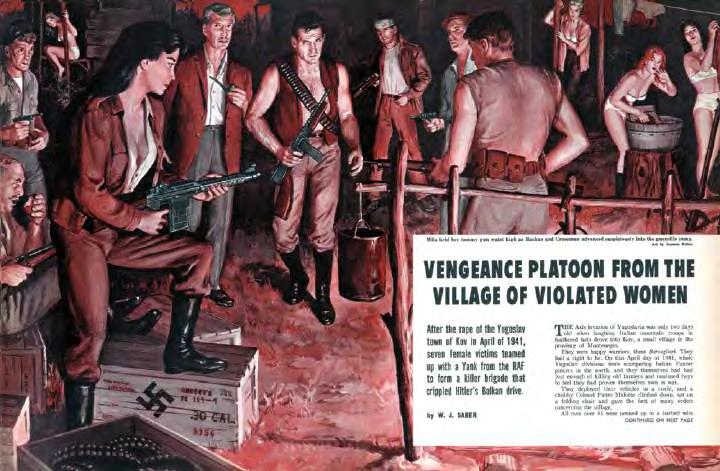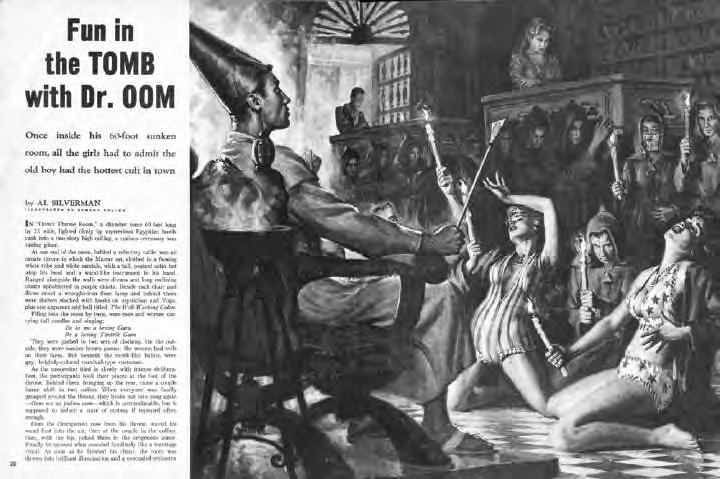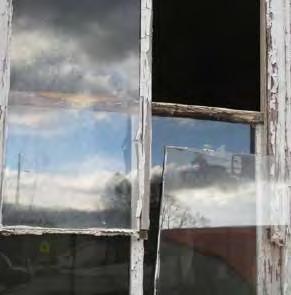



Also available from The Men’s Adventure Library: Pollen’s Action
A New Texture book
Copyright © 2018 Subtropic Productions LLC

All artwork © 2018 Samson Pollen; reproduced by arrangement with the Artist. All rights reserved.
With affectionate thanks to Jacqueline Pollen and gratitude to Rich Oberg
Archival materials provided by The Robert Deis Archive
Some pieces courtesy The David O’Dell Collection
Special research by TJ Duke
Designed by Wyatt Doyle for The Men’s Adventure Library
@NewTexture NewTexture.com
MensAdventureLibrary.com MensPulpMags.com
Booksellers: Pollen’s Women and other New Texture books are available through Ingram Book Co.
ISBN 978-1-943444-21-2
First New Texture hardcover edition: January 2018
Printed in the United States of America
Artist Samson Pollen is one of the grandmasters of illustration art used for the vintage men’s adventure magazines (MAMs) that flourished from the early 1950s to the mid-1970s. He also did top-notch illustration art for other types of periodicals and for paperback books. But most of Pollen’s artwork— literally hundreds of paintings—was created for the Atlas/Diamond group of MAMs published by Martin Goodman’s Magazine Management Company. Those included many of the best, most popular and longest running magazines in the men’s adventure genre, such as Action For Men, For Men Only, Male, Man’s World, Men, Stag, and True Action.
Pollen is currently less well known than some of the other great artists who worked for those magazines. This is largely because most examples of vintage MAM artwork shown in books and internet posts are covers, and Pollen specialized in doing interior illustrations. He did do many cover paintings for action, adventure, and romance paperbacks during his long career as an illustrator, but for MAMs, Pollen preferred—and became a go-to artist for—illustrations printed inside across the first two pages of stories.
Until now, most of the original paintings Pollen did for those two-page spreads (which were sometimes printed vertically) have never been seen. Some have been lost. Fortunately, Pollen held onto many of his originals, and others are owned by two major illustration art collectors who share our interest in increasing awareness of the men’s adventure realm: David O’Dell and Rich Oberg. It was Rich who put us touch with Pollen in 2016, around the time Sam turned 86 years old.
When we asked Sam if he’d like to collaborate on collections featuring his original artwork for our Men’s Adventure Library series, I was thrilled that he gave us the thumbs-up and full access to his paintings. Since then, we’ve had the pleasure of talking and corresponding with Sam many times.
It seemed obvious to us that one of the Pollen art books we publish should focus on his MAM artwork that features women. Images of beautiful
women were common in MAMs, and Pollen was particularly adept at painting scenes that feature beautiful women—and he did scores of them for Goodman’s Atlas/Diamond magazines.
Even the early portfolio sample painting of a group of teenage delinquents that became his first illustration in a Goodman MAM (see pg. 6) shows he had a special flair for painting female characters more complex than standard damsels in distress; Pollen’s women are often powerful or dangerous or both. Some are temptresses or femme fatales, seeking to lure a man into doing their bidding. Others are warriors, fighting alongside (or against) the male characters in the scene. There are also women in some Pollen illustrations who are relegated to being helpmates to the male protagonists. Some are simply unashamedly sexually aggressive.
But, while MAMs are of their time and thus not particularly evolved in terms of perspectives on gender roles or sexuality (despite occasional unexpectedly advanced thinking in those areas), Pollen’s women are almost never helpless victims. They also contradict the widespread misperception that MAM illustrations typically show women being abused. In fact, “bondage and torture”-style stories and artwork were only prevalent in the “sweat mag” subgenre of MAMs, which account for less than a third of the more than 160 different MAM titles that were published—and even less of the total readership. The Atlas/Diamond group Samson Pollen worked for (and most other mid- and top-tier MAMs) didn’t feature such stuff.
Another revelation comes from being able to see Pollen’s original MAM paintings. They are far more lush and painterly than you can tell from seeing them in magazine spreads, surrounded by headlines, subheads and text, and printed on medium- to low-quality paper. Samson Pollen’s paintings stand on their own as artwork. As illustration art, they also tell stories.
Artists in the realm of “fine arts” can generally choose the scenes they paint, and their paintings may or may not try to convey a story about what’s
portrayed. Professional illustrators are hired to depict scenes to accompany specific stories. Yet within the boundaries of those limitations, top illustrators like Samson Pollen are able to use their skill and imagination to create exceptional art.
Artists who created men’s adventure mag illustrations were given little to go on as far as the stories they were illuminating (usually no more than a one to three sentence description of the story), and minimal guidance from the magazine’s art director on what setting, action and characters he wanted depicted. The artist was then expected to do initial sketches, take any reference photos of models he needed, and submit a finished painting in a matter of days.

Instead of being hamstrung by the strictures of illustrating stories, Pollen soared. It was a challenge on many levels, but one that Sam not only rose to again and again, but relished. Per Sam:
“They might say something like ‘Well, the hero has an automatic weapon in one hand and he’s carrying a woman in another hand and she’s holding a dog and they’re climbing up a cliff.’ So I’d have to come up with a solution. What I would do is visualize it. I’d try to look at the scene as I’d see it in my imagination. That’s the part I liked the most: Trying to make sense out of something and create a story of it in my mind, then translate that into a painting.”
We love the paintings Samson Pollen created as a result of that process, and we believe he deserves wider recognition as an artist. Our hope is that this book will help make that happen.
—Bob DeisSomewhere near Key West, Dec. 2017
My first crush was a girl named Matilda. She wore a sailor outfit, like kids wore in those days: dark pleated skirt, sailor collar and stripes. I ran up, pulled her pigtails and ran away—but I never even spoke to her, not once. That’s the way kids are who are shy, when they have their first run-in with women, with girls.
I grew up in a good atmosphere, with my mother and sister. I think my mother was a natural born psychiatrist; she knew how to handle people. I never remember her yelling, or raising her voice at anybody. Yet she was strong, and got what she wanted without yelling or threatening—just using common sense. She had a natural ability that way. My sister, too; she became a teacher.
I was in the Coast Guard Reserve. I knew I’d be drafted, and I didn’t want to live in a foxhole. A ship is a lot cleaner; you’ve got a mattress and a sheet. When I was drafted, I went to the headquarters on Canal Street with a few pieces of my work, which I showed to one of the officers. He brought in a higher ranking officer and I ended up going up the chain to the admiral’s office. The admiral said, “Well, before you do any artwork or anything, I want you to get some salt in your blood.” He wanted me to be on a ship, to be a Coast Guardsman first. So I served overseas: Staten Island. (To me, I was overseas once I was over the Hudson River.)
I wanted more of a challenge. Working for the government, you could be kind of lax; smoke a pipe, work a little, and take the rest of the day off…. I thought it was a dead end, as far as art goes. Towards the end, they gave me a studio. It was huge. It was the size of a gym, an enormous auditorium. I had this huge studio, and I had the freedom to go for art supplies. I’d drive out in the jeep—they gave me a jeep!—and go to the art store. I’d leave the base at two in the afternoon, come and go as I pleased, and nobody complained. I’m an artist, right? I’ve got moods. People think of artists as moody people, you
know? You’ve got to let them do their thing. I took advantage of that!
I did the Titanic for the cover of Coast Guard Magazine. They really liked it. In the painting, I focused on a rowboat, up close: a woman holding a baby, an elderly woman crying, and the yeoman up there, steering the oars. I put a human touch to it. I wanted to tell a story, so I played up the human interest and that’s why they liked it, I guess. I was becoming an illustrator then.
Paperback covers by Pollen for Midwood: Orrie Hitt’s A Doctor and His Mistress (1960) and All the Way (1962) by Mike Avallone


“I’d just come out of the service, and I needed a sample to show. I made this painting on my own time, and the reason it’s one of my better ones is because that was one I handled like Norman Rockwell would handle his work: You do a careful sketch, you do a thorough drawing...you do all those things that prepare you to do a better painting. I didn’t have any editors or an author telling me what to do; it was strictly mine. I took as long as I wanted. I even got real characters, which I don’t bother with usually; I’d just hire a standard commercial model. But I went to a poolroom to get real teenagers that really looked the part. And they acted the part—they were tough guys.
“It was meant as a sample, but (Magazine Management art director) Mel Bloom liked it and used it for a story. So my first sample was bought and I worked from there on, you know? I didn’t have to shop around. I was pretty fortunate that way.
“They blew it up and put it across two pages. But it wasn’t meant to be split up; it was not a spread. They split it in a bad place and they cut the bottom half of the painting out. You’re missing the legs, which I think are important to the painting. That was a disappointment.

“I got credited for it in print: Art by SAmSon Pollen, in little letters underneath the illustration. “One of the poolroom guys had a lawyer in the family, and he sued (MM publisher) Martin Goodman for using his image without a model release. You had to have signed permission to use their picture commercially. But I didn’t know about that.
“Martin Goodman was really good to me on that, maybe because he liked my work. He said that he’d take a certain amount out of each job he gave me, and I’d pay it off that way. But he never took a penny. They made some arrangement, I guess, and I never had to pay anything. He had his own lawyers, you know.
“That’s a hell of a way to get started, right?”
When I was in my late teens and started to paint, I couldn’t afford models; I didn’t go that route. I just got a couple of kids from the neighborhood and took their pictures—reference photos. I started a couple of them on their careers, actually. Later on in life they were very successful at what they did— theater, movies, Hollywood.

There are certain characteristics that these gals had that made them decide to model. They liked a lot of attention. They were always the life of the party, and it was hello to everyone as they walked down the street...they’d be waving to everybody.
Iris Menshell was like that, I used her a few times. She lived across the street. She was friendly and lively, she really had what it took. Later, she used a different name and took on a French accent. When she came back to the neighborhood, she put her hand out elegantly and asked me to kiss her hand—with a French accent, like she’s French! She was unbelievable. But she was a beautiful girl. Years later, I saw her in a couple of Western films. [Menshell worked in film and television as Lita Milan. —Ed.]
Louisa Moritz (One Flew Over the Cuckoo’s Nest, Death Race 2000) was another model. She was on TV a lot at the time. Her specialty was children’s voices; she was really believable. She wanted to move in with me. Nothing to do with love, or anything like that; she wanted a place where she could keep costumes and stuff. It was the convenience of my apartment that interested her! She was really a live wire, very friendly. I thought she was nice.
Cathy Joyce lived around the corner. She’d wear a ball cap pulled down over her eyes, glasses...you wouldn’t believe she was a model. But when she made herself up and got in front of a camera, she was beautiful. She made most of her money on the weekend, as a belly dancer. She danced in a nightclub. She invited me one time, and boy was she good! The costumes, the color, the movement….
Ellen Burstyn, the actress, was the secretary for Scott Photography on Madison Avenue—Edna. [Burstyn was born Edna Rae Gillooly. —Ed.] She was pretty, and she filled in if a model didn’t show up and they needed someone quickly.
Shere Hite was one of my models, she lived close by. She went on to write The Hite Report, Oedipus Revisited…. She was quite some character, believe me. One time I had her in my studio with [iconic illustration model] Steve Holland, and Steve was a macho guy—a real nice guy, but kind of macho. And she was Women’s Lib all the way, so there was a little clash. And they’re Portrait of the artist as a young man: Samson Pollen at 18.

Get the rest of the story in




Swank
March 1958
“Some of My Best Friends Are Dead”

Man’s World
December 1958
“The Fraulein Spy Who Seduced Hitler”

Male May 1962

“The Reluctant Nymph”

Men
September 1962
“The Passionate Pushover”




Male
April 1970
“Diane’s Love Pad”

Stag Annual No. 12
September 1972
“One Night Stand With a Swinging Redhead”

Male
October 1963
“You Have 12 Hours to Find
Saigon’s Nude Taxi-Dancer”

Male
February 1971
“The Girl Trader”
Stag
April 1969

“Affair With a Lonesome Blonde”





Male
April 1968
“Passion Bus Trek”

Male January 1961
“The American Corporal and His ‘Virgins From Hell’ Girls”

Stag Annual No. 1
1964
“The Five Who Survived 60 Days in Japan’s Underground Giant Coffin”
Stag
January 1961

“Vengeance Platoon From the Village of Violated Women”





Man’s World
August 1967
“Showdown in Love Swap Cabana”

True Action
January 1966
“Madamoiselle Strange Legs”

Male
September 1963
“‘Dynamite’ Divorcee”

Men
August 1963
“The Invincible Harvey Stubb, American Hero Who Wouldn’t Stay Dead”


True Action
January 1969
“Give Me Cycle Love”
For Men Only
October 1966
“Oil Town Tramp”



For Men Only
October 1958
“Strange Cult of the Passionate Pastor”

Male
February 1957
“Mr. Nobody”

Men
October 1957
“Fun in the Tomb With Dr. Oom”
Stag
August 1958
“The Man Who Hated Streetwalkers”






Men
October 1959
“The Blonde Who Got a Charge Out of Death”

Men
September 1959
“Doctor Struzzi’s Nympho College”

Stag
August 1960
“Trackdown of Hitler’s Floating Love Camp”

Men
January 1960
“Girl With the Sweet Pink Toes”









Words and Pictures and Music
























